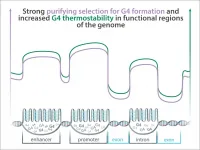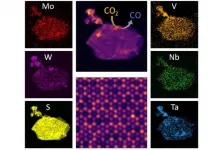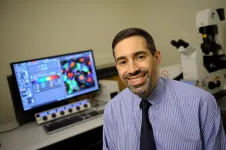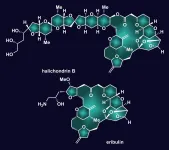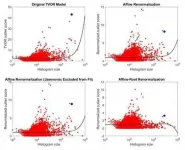(Press-News.org) Some regions of the human genome where the DNA can fold into unusual three-dimensional structures called G-quadruplexes (G4s) show signs that they are preserved by natural selection. When G4s are located in the regulatory sequences that control how genes are expressed or in other functional, but non-protein coding, regions of the genome, they are maintained by selection, are more common, and their unusual structures are more stable, according to a new study. Conversely, the structures are less common, less stable, and evolve neutrally outside of these regions, including within the protein-coding regions of genes themselves.
Together, these lines of evidence suggest that G4 elements should be added to the list of functional elements of the genome along with genes, regulatory sequences, and non-protein coding RNAs, among others. A paper describing the study, by a team of researchers led by Penn State scientists, appears June 29, 2021 in the journal Genome Research.
"There have been only a handful of studies that provided experimental evidence for individual G4 elements playing functional roles," said Wilfried Guiblet, first author of the paper, a graduate student at Penn State at the time of research, and now a postdoctoral scholar at the National Cancer Institute. "Our study is the first to look at G4s across the genome to see if they show the characteristics of functional elements as a general rule."
As much as 1% of the genome can fold into G4s, rather than the typical double helix (in comparison, protein-coding genes occupy approximately 1.5% of the genome). G4s are one of several non-canonical shapes into which DNA can fold, collectively known as "non-B DNA." The G4 structure forms in DNA sequences rich in the nucleotide guanine, the "G" in the ACGT alphabet of the genome. G4s have been implicated in several key cellular processes and have been suggested to play a role in several human diseases, including neurological disorders and cancer.
To better understand the function of G4s at a genome-wide scale, the research team looked at their distribution across the genome, their thermostability, and whether or not they showed signs of being under the influence of natural selection, all in relation to other functional elements of the genome. They confirmed that, as a rule, G4s are more common in regions of the genome known to have important cellular functions and that the G4s in these regions are more stable than elsewhere in the genome.
"The three-dimensional structure of G4s can form transiently and how stable their structure is depends on their underlying DNA sequence and other factors," said Guilbet. "We found that, usually, G4s located within functional regions of the genome tend to be more stable. In other words, it's more likely that the DNA is folded into a G4 at any given time and thus, more likely that the G4 is there for a functional reason."
Functional regions of the genome are generally maintained by a type of natural selection called purifying selection. Mutations in these regions could disrupt their function and be harmful to the organism. The mutations therefore are usually eliminated by purifying selection, which keeps the DNA sequence relatively unchanged over time. In nonfunctional regions of the genome, a mutation may have no impact and can persist in the genome without any consequences. These regions of the genome are said to evolve neutrally. Where G4s fall in this spectrum depends on their location in the genome.
"We can look at the patterns of change in a DNA sequence among human individuals and between humans and our close primate relatives as a test of natural selection and then use selection as an indicator of function," said Yi-Fei Huang, assistant professor of biology at Penn State and a leader of the research team. "Our tests show that G4s located within functional regions of the genome appear to be under purifying selections, which is further evidence that G4s should be considered as functional elements. The only exception from this pattern were protein-coding regions of genes, where G4s are relatively uncommon, rather unstable, and do not evolve under purifying selection. G4s in protein-coding regions of genes might be nonfunctional and costly to maintain."
The research team has recently shown that G4s, along with other types of non-B DNA, have increased mutation rates. The fact that G4s located outside of protein-coding regions are maintained by purifying selection, despite their high mutagenic potential, adds further weight to the evidence for classifying G4s as functional elements.
"We think that we are seeing evidence for a paradigm shift for how scientists define function in the genome," said Kateryna Makova, Verne M. Willaman Chair of Life Sciences at Penn State and a leader of the research team. "First, geneticists focused almost exclusively on protein-coding genes, then we became aware of many functional non-coding elements, and now we have G4s and possibly other non-B DNA elements. Three-dimensional structure may be just as important for defining function as the underlying DNA sequence."
"Defining the full complement of functional genome elements is crucial for interpreting the potential disease consequences not only of inherited genetic variants but also of mutations arising within tissues over the lifetime of individuals," said Kristin Eckert, professor of pathology at the Penn State College of Medicine, co-author of the paper, and a member of the research team. "The identification of G4s as novel functional elements within the human genome is key to advancing the use of genetics in precision medicine."
INFORMATION:
In addition to Guiblet, Huang, Makova, and Eckert, the research team includes Xiaoheng Cheng (now a postdoctoral researcher at the University of Chicago) and Francesca Chiaromonte, at Penn State, and Michael DeGiorgio at Florida Atlantic University. The study was funded by the U.S. National Institutes of Health, the Clinical and Translational Sciences Institute, the Institute of Computational and Data Sciences, the Huck Institutes of the Life Sciences at Penn State, the Penn State Eberly College of Science, and the U.S. National Science Foundation, and it also was supported by the CBIOS Predoctoral Training Program awarded to Penn State by the National Institutes of Health.
A two-dimensional alloy material -- made from five metals as opposed to the traditional two -- has been developed by a collaboration between researchers at the McKelvey School of Engineering at Washington University in St. Louis and researchers at the College of Engineering at the University of Illinois at Chicago.
And, in a first for such a material, it has been shown to act as an excellent catalyst for reducing CO2, into CO, with potential applications in environmental remediation.
The research, from the lab of Rohan Mishra, assistant professor in the Department of Mechanical Engineering & Materials Science at ...
A team of neuroscientists at the Beckman Institute for Advanced Science and Technology led by Baher Ibrahim and Dr. Daniel Llano published a study in eLife that furthers our understanding of how the brain perceives everyday sensory inputs.
"There is a traditional idea that the way that we experience the world is sort of like a movie being played on a projector. All the sensory information that is coming in is being played on our cerebral cortex and that's how we see things and hear things," said Llano, a Beckman researcher and associate professor in the Department of Molecular and Integrative Physiology at the University of Illinois ...
Many drivers use tollways to get from point A to point B because they are a faster and more convenient option. The fees associated with these roadways are higher during peak traffic hours of the day, such as during the commute to and from work. With this structure, drivers who are not adding to the heavy flow of traffic do not have to pay higher toll prices. However, those who utilize the toll road during more congested hours pay a premium to use the faster, more convenient highways.
Similarly, not everyone uses the same amount of electricity throughout the day. There are peak load hours that put more strain on the grid, and there are users within those times who use more electricity ...
HOUSTON - (June 29, 2021) - The story of halichondrin B, an inspirational molecule obtained from a marine creature, goes back to the molecule's discovery in an ocean sponge in 1986.
Though it has been replicated in the laboratory several times before, new work by Rice University chemists could make halichondrin B and its naturally occurring or designed variations easier to synthesize.
Synthetic chemist K.C. Nicolaou and his lab reported in the Journal of the American Chemical Society their success in simplifying several processes used to make halichondrin B and its variations.
Halichondrin's molecular structure and potent antitumor ...
Dark Energy is widely believed to be the driving force behind the universe's accelerating expansion, and several theories have now been proposed to explain its elusive nature. However, these theories predict that its influence on quantum scales must be vanishingly small, and experiments so far have not been accurate enough to either verify or discredit them. In new research published in EPJ ST, a team led by Hartmut Abele at TU Wien in Austria demonstrate a robust experimental technique for studying one such theory, using ultra-cold neutrons. Named 'Gravity Resonance Spectroscopy' (GRS), their approach could bring researchers ...
Scientists have discovered how plants manage to live alongside each other in places that are dark and shady.
Moderate shade or even the threat of shade - detected by phytochrome photoreceptors - causes plants to elongate to try to outgrow the competition.
But in the deep gloom of a dense forest or a cramped crop canopy where resources and photosynthesis are limited, this strategy doesn't work. In these conditions it would be a waste of energy and detrimental to survival to elongate stems because seedlings would never be able to over-grow larger neighbours.
So how do plants prevent elongated growth under deep shade conditions? The secret lies in their internal clocks, says the research collaboration from the John Innes Centre ...
NEW YORK (June 29, 2021)--In a new paper published in the journal Vaccine: X, public health experts from Columbia University Mailman School of Public Health, the University of Oslo, and Spark Street Advisors highlight actions to accelerate access to vaccines globally. The paper reviews the vaccine research and development process and proposes areas where reforms could increase access, speed time to market and decrease costs--from R&D to manufacturing and regulation to the management of incentives like patents and public funding.
The COVID-19 ...
A process that uses heat to change the arrangement of molecular rings on a chemical chain creates 3D-printable gels with a variety of functional properties, according to a Dartmouth study.
The researchers describe the new process as "kinetic trapping." Molecular stoppers--or speed bumps--regulate the number of rings going onto a polymer chain and also control ring distributions. When the rings are bunched up, they store kinetic energy that can be released, much like when a compressed spring is released.
Researchers in the Ke Functional Materials Group use heat to change the distribution of rings and then use moisture ...
DURHAM, N.C. - Combining structural biology and computation, a Duke-led team of researchers has identified how multiple mutations on the SARS-CoV-2 spike protein independently create variants that are more transmissible and potentially resistant to antibodies.
By acquiring mutations on the spike protein, one such variant gained the ability to leap from humans to minks and back to humans. Other variants -- including Alpha, which first appeared in the United Kingdom, Beta, which appeared in South Africa, and Gamma, first identified in Brazil - independently developed spike mutations that enhanced their ability to spread rapidly in human ...
Aerospace engineering faculty member Melkior Ornik is also a mathematician, a history buff, and a strong believer in integrity when it comes to using hard science in public discussions. So, when a story popped up in his news feed about a pair of researchers who developed a statistical method to analyze datasets and used it to purportedly refute the number of Holocaust victims from a concentration camp in Croatia, it naturally caught his attention.
Ornik is a professor in the Department of Aerospace Engineering at the University of Illinois Urbana-Champaign. He proceeded to study the research in depth and used the method to re-analyze the same data from the United ...
